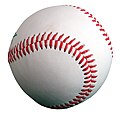Ball: Difference between revisions
←Replaced page with 'NIGGER NIGGER NIGGER NIGGER NIGGER' |
m BOT - Reverted edits by 165.29.135.110 {possible vandalism} to revision #177952975 by "Cobi". |
||
| Line 1: | Line 1: | ||
{{Otheruses}} |
|||
NIGGER NIGGER NIGGER NIGGER NIGGER |
|||
{{seealso|football (ball)}} |
|||
'''Balls''' are objects typically used in games. They are usually [[sphere|spherical]] but can be [[ovoid]]. In most [[ball game|games using balls]], the [[play]] of the game follows the state of the ball as it is hit, kicked or thrown by players. Balls can also be used for simpler activities, such as catch, [[marbles]] and [[juggling]]. Balls made from hard-wearing [[metal]] are used in [[engineering]] applications to provide frictionless bearings, known as [[Ball bearings|ball bearings]]. |
|||
Although many types of balls are today made from [[rubber]], this form was unknown outside the Americas until after the voyages of [[Christopher Columbus|Columbus]]. The Spanish were the first Europeans to see bouncing rubber balls (albeit solid and not inflated) which were employed most notably in the [[Mesoamerican ballgame]]. Balls used in various sports in other parts of the world prior to Columbus were made from other materials such as animal bladders or skins, stuffed with various materials. |
|||
== Etymology == |
|||
The first known use of the word ''ball'' in English in the sense of a globular body that is played with was in 1205 in ''{{latinx|[[Laȝamon's Brut, or Chronicle of Britain]]}}'' in the phrase, "{{latinx|Summe heo driuen balles wide ȝeond Þa feldes.}}" The word came from the [[Middle English]] ''bal'' (inflected as ''ball-e, -es'', in turn from [[Old Norse]] ''böllr'' (pronounced {{IPA|[bɔllr]}}; compare Old Swedish ''baller,'' and Swedish ''boll'') from [[Proto-Germanic]] ''ballu-z,'' (whence probably Middle High German ''bal, ball-es,'' Middle Dutch ''bal''), a [[cognate]] with [[Old High German]] ''ballo, pallo,'' Middle High German balle from Proto-Germanic ''*ballon'' (weak masculine), and Old High German ''ballâ, pallâ,'' Middle High German ''balle,'' Proto-Germanic ''*ballôn'' (weak feminine). No Old English representative of any of these is known. (The answering forms in Old English would have been ''beallu, -a, -e'' -- compare ''bealluc, ballock''.) If ''ball-'' was native in Germanic, it may have been a cognate with the Latin ''foll-is'' in sense of a "thing blown up or inflated." In the later Middle English spelling ''balle'' the word coincided graphically with the French ''balle'' "ball" and "bale", which has hence been erroneously assumed to be its source. French ''balle'' (but not ''boule'') is assumed to be of Germanic origin, itself, however. |
|||
== Images == |
|||
<gallery> |
|||
Image:RadZepMov_soccer_hires_computed_tomography_shoe_and_ball_color.jpeg|Computed tomography of a soccer ball [http://www.rad-zep.de/RadZepMov/Weltmeisterschaft-2006-Fussball/web/Radiologie-Fussball-Weltmeisterschaft-Movie-Gallerie_nl.html (Video)] |
|||
Image:Baseball (crop).jpg|[[Baseball (object)|Baseball]] |
|||
Image:Basketball.jpeg|[[Basketball (ball)|Basketball]] |
|||
Image:Cricket-ball-red-madeinaustralia.jpg|[[Cricket ball]] |
|||
Image:Billiards balls.jpg|[[Billiard ball|Billiard balls]] |
|||
Image:Lacrosse ball.jpg|[[Lacrosse ball]] |
|||
Image:Sherrin.png|[[Australian rules football]] |
|||
Image:DSC 0313.JPG|[[Tennis ball]] |
|||
Image:Wilson American football.jpg|[[Football (ball)#American and Canadian football|American Football]] |
|||
Image:Rugbyball2.jpg|[[rugby union]] |
|||
Image:Sliotar.jpg|[[Sliotar]] used in [[hurling]] |
|||
</gallery> |
|||
== See also == |
|||
* [[Super Ball]] |
|||
* [[football (ball)]] |
|||
[[Category:Balls| ]] |
|||
[[bg:Топка]] |
|||
[[ca:Pilota]] |
|||
[[cs:Míč]] |
|||
[[de:Ball]] |
|||
[[es:Pelota]] |
|||
[[eo:Pilko]] |
|||
[[eu:Baloi]] |
|||
[[fr:Ballon (sport)]] |
|||
[[gd:Bàlla]] |
|||
[[id:Bola]] |
|||
[[it:Palla (sport)]] |
|||
[[he:כדור משחק]] |
|||
[[la:Pila]] |
|||
[[lt:Kamuolys]] |
|||
[[nl:Bal (voorwerp)]] |
|||
[[ja:ボール]] |
|||
[[nn:Ball]] |
|||
[[pl:Piłka]] |
|||
[[pt:Bola]] |
|||
[[qu:Piluta]] |
|||
[[ru:Игры с мячом]] |
|||
[[simple:Ball]] |
|||
[[sl:Žoga]] |
|||
[[fi:Pallo (peliväline)]] |
|||
[[sv:Boll]] |
|||
[[ta:பந்து]] |
|||
[[tr:Top (spor)]] |
|||
[[uk:М'яч]] |
|||
[[zh-yue:波]] |
|||
Revision as of 21:06, 14 December 2007
Balls are objects typically used in games. They are usually spherical but can be ovoid. In most games using balls, the play of the game follows the state of the ball as it is hit, kicked or thrown by players. Balls can also be used for simpler activities, such as catch, marbles and juggling. Balls made from hard-wearing metal are used in engineering applications to provide frictionless bearings, known as ball bearings.
Although many types of balls are today made from rubber, this form was unknown outside the Americas until after the voyages of Columbus. The Spanish were the first Europeans to see bouncing rubber balls (albeit solid and not inflated) which were employed most notably in the Mesoamerican ballgame. Balls used in various sports in other parts of the world prior to Columbus were made from other materials such as animal bladders or skins, stuffed with various materials.
Etymology
The first known use of the word ball in English in the sense of a globular body that is played with was in 1205 in Template:Latinx in the phrase, "Template:Latinx" The word came from the Middle English bal (inflected as ball-e, -es, in turn from Old Norse böllr (pronounced [bɔllr]; compare Old Swedish baller, and Swedish boll) from Proto-Germanic ballu-z, (whence probably Middle High German bal, ball-es, Middle Dutch bal), a cognate with Old High German ballo, pallo, Middle High German balle from Proto-Germanic *ballon (weak masculine), and Old High German ballâ, pallâ, Middle High German balle, Proto-Germanic *ballôn (weak feminine). No Old English representative of any of these is known. (The answering forms in Old English would have been beallu, -a, -e -- compare bealluc, ballock.) If ball- was native in Germanic, it may have been a cognate with the Latin foll-is in sense of a "thing blown up or inflated." In the later Middle English spelling balle the word coincided graphically with the French balle "ball" and "bale", which has hence been erroneously assumed to be its source. French balle (but not boule) is assumed to be of Germanic origin, itself, however.
Images
-
Computed tomography of a soccer ball (Video)











